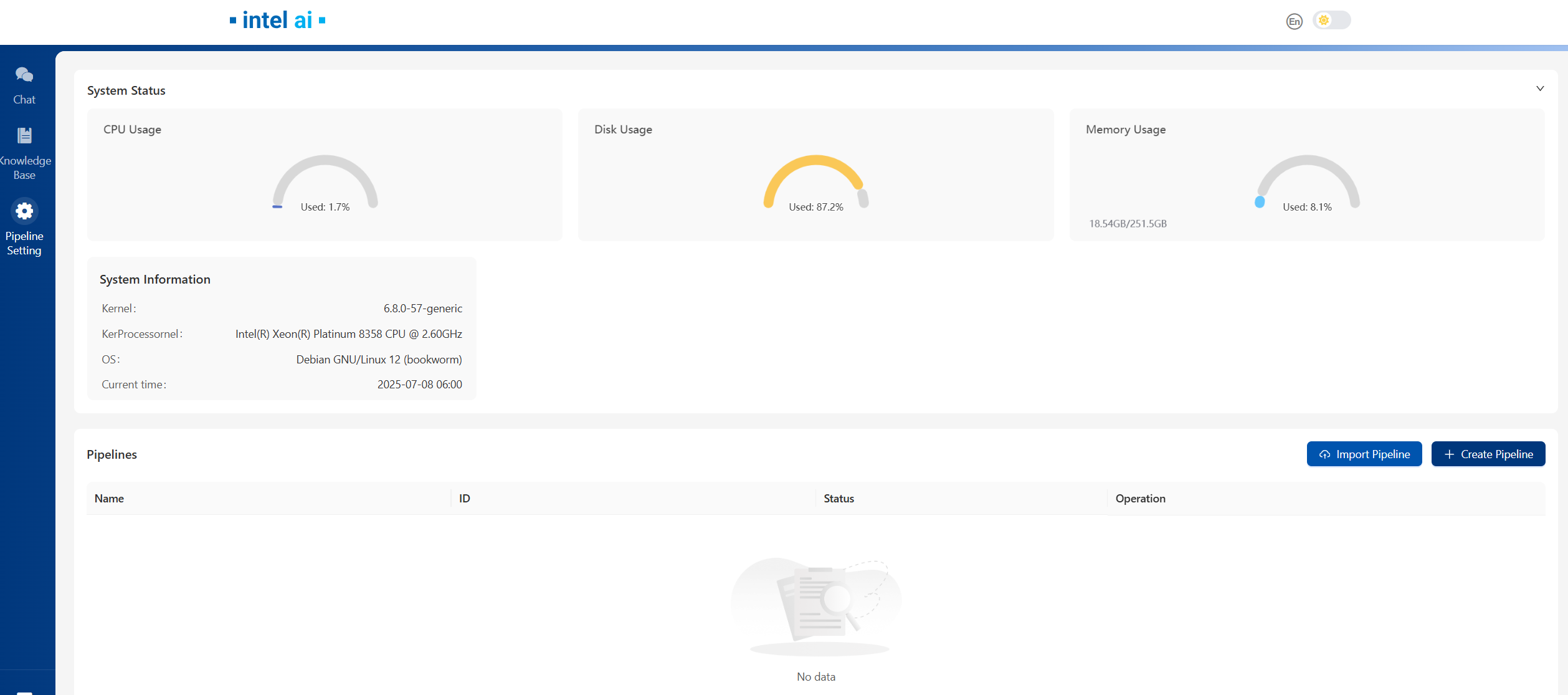Example Edge Craft Retrieval-Augmented Generation Deployment on Intel® Arc® Platform¶
This document outlines the deployment process for Edge Craft Retrieval-Augmented Generation service on Intel Arc server. This example includes the following sections:
EdgeCraftRAG Quick Start Deployment: Demonstrates how to quickly deploy a Edge Craft Retrieval-Augmented Generation service/pipeline on Intel® Arc® platform.
EdgeCraftRAG Docker Compose Files: Describes some example deployments and their docker compose files.
EdgeCraftRAG Service Configuration: Describes the service and possible configuration changes.
EdgeCraftRAG Quick Start Deployment¶
This section describes how to quickly deploy and test the EdgeCraftRAG service manually on Intel® Arc® platform. The basic steps are:
1. Prerequisites¶
EC-RAG supports vLLM deployment(default method) and local OpenVINO deployment for Intel Arc GPU. Prerequisites are shown as below:
Hardware: Intel Arc A770
OS: Ubuntu Server 22.04.1 or newer (at least 6.2 LTS kernel)
Driver & libraries: please to Installing GPUs Drivers for detailed driver & libraries setup
Hardware: Intel Arc B60
please to Install Native Environment for detailed setup
Below steps are based on vLLM as inference engine, if you want to choose OpenVINO, please refer to OpenVINO Local Inference
2. Access the Code¶
Clone the GenAIExample repository and access the EdgeCraftRAG Intel® Arc® platform Docker Compose files and supporting scripts:
git clone https://github.com/opea-project/GenAIExamples.git
cd GenAIExamples/EdgeCraftRAG
Checkout a released version, such as v1.5:
git checkout v1.5
3. Prepare models¶
# Prepare models for embedding, reranking:
export MODEL_PATH="${PWD}/models" # Your model path for embedding, reranking and LLM models
mkdir -p $MODEL_PATH
pip install --upgrade --upgrade-strategy eager "optimum[openvino]"
optimum-cli export openvino -m BAAI/bge-small-en-v1.5 ${MODEL_PATH}/BAAI/bge-small-en-v1.5 --task sentence-similarity
optimum-cli export openvino -m BAAI/bge-reranker-large ${MODEL_PATH}/BAAI/bge-reranker-large --task text-classification
# Prepare LLM model
export LLM_MODEL="Qwen/Qwen3-8B" # Your model id
pip install modelscope
modelscope download --model $LLM_MODEL --local_dir "${MODEL_PATH}/${LLM_MODEL}"
# Optionally, you can also download models with huggingface:
# pip install -U huggingface_hub
# huggingface-cli download $LLM_MODEL --local-dir "${MODEL_PATH}/${LLM_MODEL}"
4. Prepare env variables and configurations¶
Prepare env variables for vLLM deployment¶
ip_address=$(hostname -I | awk '{print $1}')
# Use `ip a` to check your active ip
export HOST_IP=$ip_address # Your host ip
# Check group id of video and render
export VIDEOGROUPID=$(getent group video | cut -d: -f3)
export RENDERGROUPID=$(getent group render | cut -d: -f3)
# If you have a proxy configured, execute below line
export no_proxy=${no_proxy},${HOST_IP},edgecraftrag,edgecraftrag-server
export NO_PROXY=${NO_PROXY},${HOST_IP},edgecraftrag,edgecraftrag-server
# If you have a HF mirror configured, it will be imported to the container
# export HF_ENDPOINT=https://hf-mirror.com # your HF mirror endpoint"
# Make sure all 3 folders have 1000:1000 permission, otherwise
export DOC_PATH=${PWD}/tests
export TMPFILE_PATH=${PWD}/tests
chown 1000:1000 ${MODEL_PATH} ${DOC_PATH} ${TMPFILE_PATH}
# In addition, also make sure the .cache folder has 1000:1000 permission, otherwise
chown 1000:1000 -R $HOME/.cache
For more advanced env variables and configurations, please refer to Prepare env variables for vLLM deployment
5. Deploy the Service on Intel GPU Using Docker Compose¶
set Milvus DB and chat history round for inference:
# EC-RAG support Milvus as persistent database, by default milvus is disabled, you can choose to set MILVUS_ENABLED=1 to enable it
export MILVUS_ENABLED=0
# If you enable Milvus, the default storage path is PWD, uncomment if you want to change:
# export DOCKER_VOLUME_DIRECTORY= # change to your preference
# EC-RAG support chat history round setting, by default chat history is disabled, you can set CHAT_HISTORY_ROUND to control it
# export CHAT_HISTORY_ROUND= # change to your preference
option a. Deploy the Service on Arc A770 Using Docker Compose¶
export VLLM_SERVICE_PORT_A770=8086 # You can set your own port for vllm service
# Launch EC-RAG service with compose
docker compose --profile a770 -f docker_compose/intel/gpu/arc/compose.yaml up -d
option b. Deploy the Service on Arc B60 Using Docker Compose¶
# Besides MILVUS_ENABLED and CHAT_HISTORY_ROUND, below environments are exposed for vLLM config, you can change them to your preference:
# export VLLM_SERVICE_PORT_B60=8086
# export DTYPE=float16
# export TP=1 # for multi GPU, you can change TP value
# export DP=1
# export ZE_AFFINITY_MASK=0 # for multi GPU, you can export ZE_AFFINITY_MASK=0,1,2...
# export ENFORCE_EAGER=1
# export TRUST_REMOTE_CODE=1
# export DISABLE_SLIDING_WINDOW=1
# export GPU_MEMORY_UTIL=0.8
# export NO_ENABLE_PREFIX_CACHING=1
# export MAX_NUM_BATCHED_TOKENS=8192
# export DISABLE_LOG_REQUESTS=1
# export MAX_MODEL_LEN=49152
# export BLOCK_SIZE=64
# export QUANTIZATION=fp8
docker compose --profile b60 -f docker_compose/intel/gpu/arc/compose.yaml up -d
6. Access UI¶
Open your browser, access http://${HOST_IP}:8082
Your browser should be running on the same host of your console, otherwise you will need to access UI with your host domain name instead of ${HOST_IP}.
Below is the UI front page, for detailed operations on UI and EC-RAG settings, please refer to Explore_Edge_Craft_RAG

7. Cleanup the Deployment¶
To stop the containers associated with the deployment, execute the following command:
docker compose -f docker_compose/intel/gpu/arc/compose.yaml down
All the EdgeCraftRAG containers will be stopped and then removed on completion of the “down” command.
EdgeCraftRAG Docker Compose Files¶
The compose.yaml is default compose file using tgi as serving framework
Service Name |
Image Name |
|---|---|
etcd |
quay.io/coreos/etcd:v3.5.5 |
minio |
minio/minio:RELEASE.2023-03-20T20-16-18Z |
milvus-standalone |
milvusdb/milvus:v2.4.6 |
edgecraftrag-server |
opea/edgecraftrag-server:latest |
edgecraftrag-ui |
opea/edgecraftrag-ui:latest |
ecrag |
opea/edgecraftrag:latest |
EdgeCraftRAG Service Configuration¶
The table provides a comprehensive overview of the EdgeCraftRAG service utilized across various deployments as illustrated in the example Docker Compose files. Each row in the table represents a distinct service, detailing its possible images used to enable it and a concise description of its function within the deployment architecture.
Service Name |
Possible Image Names |
Optional |
Description |
|---|---|---|---|
etcd |
quay.io/coreos/etcd:v3.5.5 |
No |
Provides distributed key-value storage for service discovery and configuration management. |
minio |
minio/minio:RELEASE.2023-03-20T20-16-18Z |
No |
Provides object storage services for storing documents and model files. |
milvus-standalone |
milvusdb/milvus:v2.4.6 |
No |
Provides vector database capabilities for managing embeddings and similarity search. |
edgecraftrag-server |
opea/edgecraftrag-server:latest |
No |
Serves as the backend for the EdgeCraftRAG service, with variations depending on the deployment. |
edgecraftrag-ui |
opea/edgecraftrag-ui:latest |
No |
Provides the user interface for the EdgeCraftRAG service. |
ecrag |
opea/edgecraftrag:latest |
No |
Acts as a reverse proxy, managing traffic between the UI and backend services. |